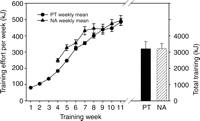How your body responds to new training programs
Today I spent the whole day chopping wood and moving furniture around for my mother. To say that I am sore right now would be an understatement. That being said, I know that it’s just my body responding to a novel training stimuli. The same thing happens when we start new training programs. However, at some point the pain/soreness goes away, which leads some people to believe that their workouts are no longer effective. And that my friends, isn’t necessarily true. In fact there’s even research show that you don’t need to be sore to make gains. See below for more:
In a recent study published in the Journal of Experimental Biology, researchers split male and female athletes into two groups. They then had them take part in a rigorous 8-week training program. Although, Group 1 was given an additional three weeks of “gradual” training before the training got intense. Basically, Group 1 was able to ease into the training before having to “hit it hard”, whereas Group 2 went all out right away.
What’s interesting is that during the entire study, both groups did the same amount of total work. That means Group 1 spread this over 11 weeks with the first three weeks being a little easier than the last eight. Whereas Group 2 spread this over eight weeks and, as mentioned, went all-out right from the get-go. In other words, Group 2 had it much tougher during their training. However, Group 1 wasn’t far behind and during the last few weeks their intensity level was about the same as Group 2’s. See the chart below for this.
At the end of the study, Group 2 had higher creatine kinase levels (a marker of muscle damage) in their bloodstream than Group 1 – over five times more! Group 2 also reported higher levels of muscle soreness and exertion than Group 1. In spite of this, muscle size and strength gains were similar in both groups by the end of the study. Therefore, while muscle soreness may indicate you did some damage in the gym, it’s not the “end all, be all” to building bigger, stronger muscles or program effectiveness.
Flann, KL et al. (2011) Muscle damage and muscle remodeling: no pain, no gain? The Journal of Experimental Biology. 214, 674-679.
